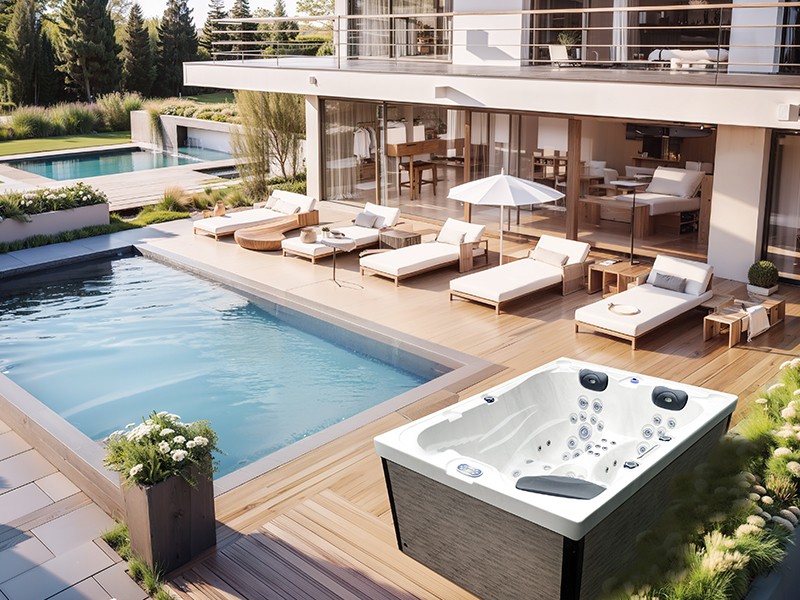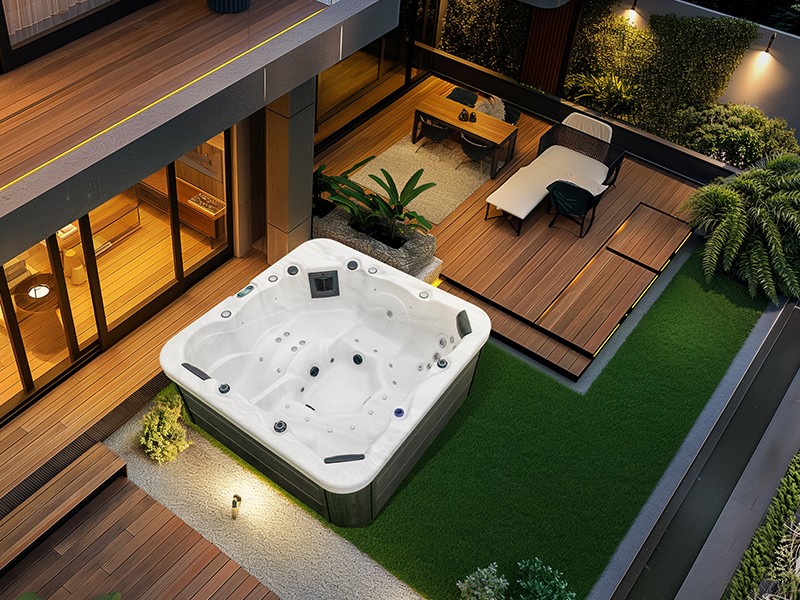
Best Hot Tub Insulation Types Comparison, Which One is the Best?
2024-10-01 15:30Hot tubs are not only an important facility for modern families to enjoy relaxing time, but also an ideal place to keep family members healthy and energetic. Whether it is a cold winter night or a cool autumn day, a high-performance hot tub can provide a warm and comfortable experience. However, in order to maintain the ideal water temperature during long-term use and reduce energy consumption, a key factor is the insulation performance of the hot tub. Insulation not only affects the stability of water temperature, but also directly relates to operating costs and user experience.
This article will take a deep look at various insulation materials and their applications in hot tubs, and compare which insulation types are best for different needs.
What Is Insulation?
Insulation materials refer to substances that can effectively prevent or slow the flow of heat. These materials play a role in heat preservation or insulation by reducing the speed at which heat is transferred from one area to another. Common insulation materials include foam plastics, fiber materials, rubber, and certain synthetic materials with high thermal resistance. In the application of hot tubs, the main task of insulation materials is to maintain water temperature and reduce heat loss, thereby improving energy efficiency.
Thermal resistance and thermal conductivity of insulation materials
Thermal resistance (R-value) and thermal conductivity (k-value) are two important indicators when evaluating insulation materials. The higher the thermal resistance, the better the insulation performance of the material; the lower the thermal conductivity, the slower the material transfers heat. Therefore, it is important to consider its thermal resistance and thermal conductivity when selecting the right insulation material.
How Are Hot Tubs Insulated?
The insulation system of a hot tub usually relies on a combination of several different insulation technologies to minimize heat loss. The water in a hot tub is heated by a heater, which maintains the water temperature at a set temperature. However, without effective insulation measures, the water temperature will drop rapidly, causing the heater to start frequently and increase energy consumption.
Heat loss pathways in hot bathtub structures
1. Surface heat conduction: The heat of the water body is conducted to the outside air through the wall of the tub.
2. Convection: Heat is lost from the part of the water surface that contacts the air through convection.
3. Evaporation: When the water evaporates, it takes away a lot of heat, which is one of the main reasons for heat loss in hot wayer tubs.
To combat these heat losses, quality hot tubs use multi-layer insulation structures and highly efficient insulation materials to ensure the stability of water temperature.
The Best Hot Tubs Use the Same Insulation Materials as Industrial Freezers
Industrial freezer insulation materials
Industrial freezers need to maintain internal temperatures under extreme conditions, so their insulation materials usually have extremely high thermal resistance properties. These materials can not only effectively prevent external heat from entering, but also prevent internal cold from escaping. Some high-end hot tub manufacturers have borrowed this insulation technology and applied it to the design of hot water tubs. This material is usually a high-density polyurethane foam or similar high-efficiency insulation material, which can significantly improve the insulation performance of hot bathtubs.
High-density insulation materials used in hot tubs
The use of high-density insulation materials in hot bathtubs can not only effectively reduce heat loss, but also provide additional structural support. The application of this material allows hot bathtubs to maintain water temperature during long-term use, reduce the operating frequency of the heater, and thus reduce operating costs. This is why more and more consumers will consider products that use similar industrial freezer insulation materials when purchasing hot tubs.
What Are the Different Types of Hot Tub Insulation Materials?
Full Foam Insulation
Full foam insulation is a very common method of hot tub insulation. As the name implies, this method almost completely fills the interior space of the hot tub with foam material. Foam not only provides excellent insulation, but also increases structural strength and reduces vibration and noise. Full foam insulation usually uses polyurethane foam, which is known for its good thermal resistance and lightweight structure.
Advantages of Full Foam Insulation:
The main advantages of full foam insulation include excellent insulation performance and structural support capabilities. It can significantly reduce the energy consumption of hot tubs and extend the service life. However, due to the high material cost of full foam insulation and the need to dig out part of the foam during maintenance, its maintenance difficulty and cost are relatively high.
Partial Foam Insulation
Partial foam insulation reduces the amount of foam used compared to full foam insulation and only fills key areas. Although this method is slightly inferior in insulation effect, its advantages are reduced material use, reduced costs, and greater convenience for hot water tub repair and maintenance.
Advantages of partial foam insulation:
Advantages include lower cost and easier maintenance, because the interior space of the hot tub is not completely filled with foam material, which makes it easier for maintenance personnel to inspect or repair pipes. Disadvantages are that its insulation effect is not as good as full foam insulation, which may lead to higher energy consumption and unstable water temperature.
Hot wrap insulation
Hot wrap insulation is a relatively new insulation method that uses a principle similar to heat reflective barriers. By wrapping multiple layers of reflective material on the outer wall of the hot tub, hot wrap insulation can effectively reflect and retain the heat inside. The advantages of this method are that it is light and easy to install without affecting the maintainability of the hot water tub.
Advantages of hot wrap insulation:
The biggest advantage of hot wrap insulation is its light weight and operability. Compared with traditional foam insulation, hot wrap insulation does not increase the weight of the hot tub while maintaining good insulation performance. In addition, this material can be flexibly applied during installation without affecting subsequent maintenance and repairs.
Fiber-Reinforced Plastic (FiberCor) Insulation
FiberCor is an insulation material specifically designed for hot tubs that combines the lightweight of fiber materials with the insulating properties of foam materials. Unlike traditional foam materials, FiberCor has a high degree of plasticity and can be filled into all gaps inside the hot tub, providing seamless insulation. In addition, FiberCor's fiber structure has a sound-absorbing effect, which can effectively reduce the operating noise of the hot tub.
Advantages of FiberCor Insulation:
FiberCor material has a higher thermal resistance than traditional foam materials, which can effectively maintain water temperature. Compared with full foam insulation, FiberCor material is lighter and does not add burden to the hot bathtub. In addition, due to the high plasticity of FiberCor material, it can be easily cleaned locally during maintenance without damaging the overall structure.
Multi-density full foam insulation
Multi-density full foam insulation is an advanced insulation technology that optimizes the insulation effect by using different densities of foam materials in different areas of the hot bathtub. High-density foam is used in areas that require stronger structural support, while low-density foam is used in other areas. This method can not only improve the overall insulation performance, but also effectively control the weight and cost of the hot tub.
Advantages of multi-density full foam insulation:
Multi-density foam materials can provide optimal thermal resistance performance according to needs and reduce heat loss. Secondly, by accurately configuring the material density, multi-density full foam insulation technology reduces unnecessary material use and reduces costs. In addition, using high-density foam in areas that require support can effectively enhance the overall structural strength of the hot tub and extend its service life.
What Is an Uninsulated Hot Tub?
Uninsulated hot tubs are those that do not use any specialized insulation materials. Such hot water tubs are usually simple in structure and low in price, but they face greater heat loss during use. Users of uninsulated hot bathtubs usually need to run the heater frequently to keep the water warm, which not only increases energy consumption but also reduces the comfort of use.
Although uninsulated hot tubs are far inferior to other types in terms of insulation performance, they still have a certain market in certain specific scenarios. For example, hot tubs that are used for short periods of time or only in warm climates may not require a complex insulation system. In addition, this type of hot tub is suitable for consumers with limited budgets due to its low cost.
What Are Some Ways to Optimize Hot Tub Insulation?
Add a hot tub cover
A hot tub cover is the most direct and effective insulation tool. It prevents heat from evaporating through the water surface and reduces the cooling effect of ambient air on the water body. Choosing a high-quality hot tub cover, especially one with a thick insulating layer, can significantly improve the insulation effect.
Regular cleaning and maintenance
Making sure that the hot tub's filter and water pump are in good condition can help keep the water circulating and the heat evenly distributed. Regularly checking and cleaning the hot tub's insulation to ensure that it is not damaged or aged is also an important measure to maintain its insulation performance.
Install windbreaks
If the hot tub is located outdoors, installing windbreaks such as wind screens or guardrails can reduce the direct impact of cold wind on the outer wall of the hot bathtub, thereby reducing heat loss. In addition, windbreaks can also provide a certain degree of privacy protection and enhance the user experience.
Adjust the water temperature
Adjusting the water temperature according to the season and usage habits can reduce unnecessary heat waste. For example, the water temperature can be set slightly lower in the summer and appropriately increased in the winter to meet the comfort needs in different environments.
How Much Does it Cost to Run a Hot Tub?
Factors that affect operating costs
1. Insulation performance: The quality and type of insulation material directly affects the insulation effect of the hot water tub, which in turn affects the operating frequency and energy consumption of the heater.
2. Water temperature setting: Higher water temperatures require more energy to maintain, especially in cold seasons.
3. Frequency of use: The higher the frequency of use, the more frequently the hot tub's heater and circulation system work, and the corresponding electricity and maintenance costs will also increase.
4. Water quality maintenance: Keeping the water clean requires regular use of chemicals and cleaning equipment, which is also an ongoing expense.
Estimating operating costs
Generally speaking, the operating costs of a hot tub include electricity, water, and chemicals. For a standard-sized hot tub, the monthly operating cost is usually between $20 and $50. This figure may fluctuate due to regional differences in electricity costs and different usage habits.
In summary, choosing the best hot bathtub insulation type can not only effectively reduce operating costs, but also improve the user experience. Different types of insulation materials have their own advantages, and consumers should choose according to their needs and budget. Whether it is high-efficiency full foam insulation, multi-density full foam insulation, or innovative FiberCor insulation material, the one that suits you is the best.
Hot Tub Insulation Comparison Chart
| Type of hot tub insulation | Example | Pros | Cons |
| No insulation | Inflatable hot tub | Cheap | Vulnerable to freezing, expensive to run |
| Partial foam | Rotationally molded spa | Purchase price on the low end; may be acceptable in warmer climates | Vulnerable to freezing, more expensive to run than full foam |
| Thermal wrap | Swim spa | Provides basic insulation for a lower temp heated pool | Cannot meet the demands of a hot tub |
| Full Foam | Modern mid quality spa brands | Insulation fills the cabinet and eliminates air flow that allows heat to escape | Single density full foam does not provide greatest energy efficiency. Higher density can't be used because of expansion. |
| FiberCor® | Modern top quality spas, including Limelight and HotSpot collections ®® | Loose, wool-like fibers provide the same insulation value as high density polyurethane foam, but are easy to remove when repair is needed | Less insulation value than multi-density full foam |
| Multi-density full foam | Modern premium quality spas, including Highlife and Highlife NXT collections ®® | Greatest energy efficiency and lowest possible operating costs | Highest price range |






